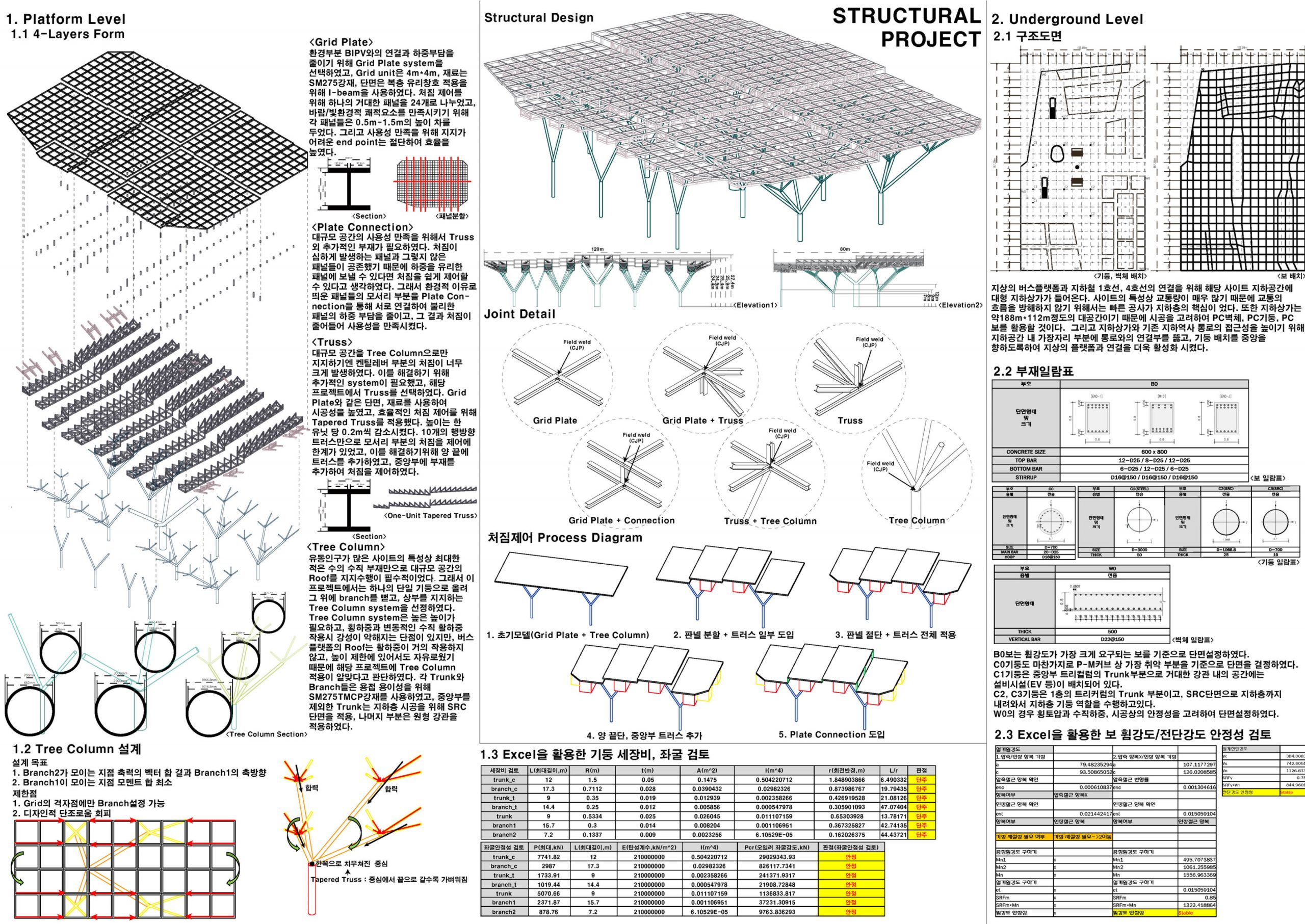김현호(구조), 권상오(환경), 지준(CM)
Hyeonho Kim (structure), Sangoh Kwon (environment), Jun Ji (CM)
기차를 타고 서울을 방문하는 사람들이 마주한 서울의 첫 인상은, 육중한 서울스퀘어와 수많은 자동차들이 바삐 오가는 역전 환승센터이다. 서울역 인근 10여개 버스 정류장을 통합한다는 야심찬 계획 아래 2009년 완공된 서울역 버스환승센터는 90종이 넘는 버스 노선이 정차하고 하루 평균 5만여명이 찾는다.
그러나, 환승센터를 이용하는 이용객과 차량은 많은 불편을 겪고 있다. 버스 승강장은 여러 군데 흩어져 있어 혼란을 유발한다. 5, 6번 승강장을 이용하는 버스 노선들은 회차하며 심각한 교통 체증을 유발한다. 보행자는 110m가 넘는 도로를 건너 횡단해야 하는 위험한 상황에 놓여 있으며, 폭우, 한파, 그리고 매연과 같은 외부 악조건에 그대로 노출된다.
본 프로젝트는 환승센터 일대를 재개발하여 상술한 문제들을 해소하는 것을 목표로 한다. 지상부 차선과 대합실을 재배치하고 거대한 구조물로 덮어 교통흐름 개선, 보행환경 개선을 이룬다. 지하 공간은 1호선 역사를 확장하여 환승 편의성을 증진하고, 상가를 배치하여 프로젝트의 수익성을 개선함과 동시에 이용객들이 사용할 수 있게 한다. 지하공간 중앙부는 Sunken을 통해 자연채광을 들인다.
구조설계는 지상층의 동선방해가 없도록 수직부재를 최소화하며 동시에 대규모 공간의 지붕층 처짐을 제어하는 방안에 대해 발전시키는 것을 목표로 잡았다. 판넬의 분할/절단, 트러스의 도입/추가/변형, 새로운 부재의 활용까지 점차 단계를 밟아가며 사용성을 만족시키도록 설계하였다. 그리고 직접 Excel표를 만들어 기둥의 좌굴 안전성, 보의 휨/전단 안전성을 판단할 수 있는 기준을 만들었고, 그것을 바탕으로 tree column과 지하층의 보 단면을 설계하였다.
환경설계는 지상 승강장과 대합실의 일사량과 지하공간의 조도를 제어하는 것에 초점을 두었다. 우선 다목적 최적화를 활용하여 태양광 패널을 지붕에 배치하여, 일사 차단과 전력 생산을 가능토록 설계하였다. 그리고 옥외공간의 특성을 고려한 환경평가 지표를 사용하여 파레토 최적 지점을 비교하여 최적 설계안을 선택하였다.
CM은 프로젝트를 현실화하기 위한 방안들을 마련하는 것을 목표로 하였다. 프로젝트에 필요한 비용을 마련하기 위해 프로그램을 계획하고, 사업 구조를 계획하였다. 이를 바탕으로 프로그램의 cash-flow를 검토하고, 도출된 투자지표를 바탕으로 사업성을 검토하였다. 그리고 공사기간 중 교통 흐름이 끊기지 않아야 한다는 제약조건을 고려하여 주요 공종 공정계획을 수립하고, 공정표를 작성하였다.
The first impression that people visiting Seoul by train encounter is the bustling Seoul Square and the busy interchange center with numerous cars. Under an ambitious plan to integrate around 10 bus stops near Seoul Station, the Seoul Station Bus Transfer Center was completed in 2009, accommodating over 90 bus routes and attracting an average of over 50,000 visitors daily.
However, both passengers and vehicles using the transfer center face many inconveniences. Bus platforms are scattered in various locations, causing confusion. Bus routes using platforms 5 and 6 cause severe traffic congestion as they turn around. Pedestrians are exposed to dangerous situations, having to cross a road over 110 meters wide, and are vulnerable to adverse weather conditions such as heavy rain, cold waves, and air pollution.
The aim of this project is to redevelop the vicinity of the transfer center to address the aforementioned issues. It involves relocating the above-ground lanes and concourse and covering them with a massive structure to improve traffic flow and pedestrian environment. The underground space will be expanded by extending Line 1 and enhanced for transfer convenience, while also accommodating commercial facilities to improve profitability and serve the users. The central part of the underground space will incorporate Sunken areas to allow natural lighting.
The structural design aims to minimize vertical members so that there is no interference with the movement of the ground level and at the same time develop ways to control the deflection of the roof level in large spaces. It is designed to satisfy serviceability by gradually taking steps from panel division/cutting, introduction/addition/deformation of truss, and utilization of new members. In addition, an Excel table was created to determine the buckling safety of the column and the bending/shear safety of the beam, and based on that, the tree column and the beam cross-section of the underground level were designed.
Environmental design focused on the solar radiation of platforms and the illumination of underground areas. At first, photovoltaic panels were installed on the roof to block the sunlight and produce electric power. Multi-Objective Optimization determined their location. Then, an optimal design was selected by comparing several Pareto optimal sets. An environment-evaluating index for the outdoor condition was used during the process.
Construction management (CM) aims to develop strategies to realize the project. Programs and business structures are planned to secure the necessary funds for the project. Based on this, the cash flow of the program is reviewed, and investment indicators are derived to assess the feasibility. Considering the constraint that traffic flow should not be disrupted during the construction period, major construction processes and schedules are established, and process charts are created.



